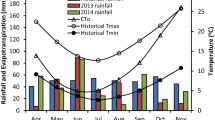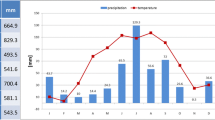Abstract
Wheat yields in the Mediterranean climate of Western and Southern Australia are often limited by water. Our measurements on a 70 ha growers field showed linear relationships between grain yield and the plant available soil water storage capacity (PAWc) of the top 100 cm of the soil profile. PAWc was linearly related to apparent soil electrical conductivity measured by proximal sensing using electromagnetic induction (EM38). The APSIM wheat model also employs PAWc as one of the systems parameters and simulated linear relationships between PAWc and yield. These relationships were used to transform an EM38-derived PAWc map of the field into yield maps for three major season types (dry, medium and wet) and nitrogen (N) fertiliser management scenarios. The results indicated that the main cause of temporal and spatial yield variability within the field was due to interactions of seasonal rainfall, PAWc and N fertiliser applications. Spatial variability was low in low rainfall years when yields across the field were low and the higher soil water storage capacity sites were often underutilised. With adequate N, spatial variability increased with seasonal rainfall as sites with higher PAWc conserved more water in wet seasons to give higher yield response than sites with low PAWc. The higher yield response of high PAWc sites to rainfall gave rise to larger temporal variability compared with sites with low PAWc. Provision of adequate N is required for the water limited yield potential to be expressed and this increased both spatial and temporal variability. Sites with low PAWc performed poorly irrespective of rainfall and N application. PAWc is inherently low on deep coarse sands; these sites should be considered for a change in land use. Elsewhere, strategic management interventions should aim to improve PAWc through sub-soil amelioration and deep root growth to increase the capital asset of the farm. The resulting increase in yields will occur in favourable seasons and with adequate fertiliser provisions. The largest grain yield response to water and N will be obtained on sites with the highest PAWc and it is at those sites that the greatest profits from fertiliser use could be achieved in wet seasons.
Similar content being viewed by others
References
T M Addiscott N A Mirza (1998) ArticleTitleModelling contaminant transport at catchment or regional scale Agric. Ecosyst. Environ. 67 211–221 Occurrence Handle10.1016/S0167-8809(97)00120-5
S Asseng B A Keating I R P Fillery P J Gregory J W Bowden N C Turner J A Palta D G Abrecht (1998) ArticleTitlePerformance of the APSIM-wheat model in Western Australia Field Crops Res. 57 163–179 Occurrence Handle10.1016/S0378-4290(97)00117-2
S Asseng A F Herwaarden ParticleVan (2003) ArticleTitleAnalysis of the benefits to wheat yield from assimilates stored prior to grain filling in a range of environments Plant and Soil 256 217–229 Occurrence Handle1:CAS:528:DC%2BD3sXot1ClsLY%3D Occurrence Handle10.1023/A:1026231904221
S Asseng H Keulen ParticleVan W Stol (2000) ArticleTitlePerformance and application of the APSIM–N-wheat model in the Netherlands Eur. J. Agron. 12 37–54 Occurrence Handle10.1016/S1161-0301(99)00044-1
B Basso J T Ritchie F J Pierce R P Braga J W Jones (2001) ArticleTitleSpatial validation of crop models for precision agriculture Agric. Sys. 68 97–112 Occurrence Handle10.1016/S0308-521X(00)00063-9
W D Batchelor B Basso J O Paz (2002) ArticleTitleExamples of strategies to analyse spatial and temporal yield variability using crop models Eur. J. Agron. 18 141–158 Occurrence Handle10.1016/S1161-0301(02)00101-6
M S Cox P D Gerard M C Wardlaw M J Abshire (2003) ArticleTitleVariability of selected soil properties and their relationships with soybean yield Soil Sci. Soc. Am. J. 67 1296–1302 Occurrence Handle1:CAS:528:DC%2BD3sXlslCqurc%3D Occurrence Handle10.2136/sssaj2003.1296
R A Fisher G N Howe Z M Ibrahim (1993) ArticleTitleIrrigated spring wheat and timing and amount of nitrogen fertilizer. 1. Grain yield and protein content Field Crops Res. 33 37–56 Occurrence Handle10.1016/0378-4290(93)90093-3
T J Hatton G A Bartle R P Silberstein R B Salame G Hodgson P R Ward P Lambert D R Williamson (2002) ArticleTitlePredicting and controlling water logging and groundwater flow in sloping duplex soils in western Australia Agric. Water Manage. 53 57–81 Occurrence Handle10.1016/S0378-3774(01)00156-1
A Irmak W D Batchelor J W Jones S Irmak J O Paz H W Beck M Egeh (2002) ArticleTitleRelationship between plant available soil water and yield for explaining soybean yield variability Appl. Eng. Agric. 18 471–482
C K Johnson J W Doran H R Duke B J Wienhold K M Eskridge J F Shanahan (2001) ArticleTitleField-scale electrical conductivity mapping for delineating soil condition Soil Sci. Soc. Am. J. 65 1829–1837 Occurrence Handle1:CAS:528:DC%2BD38Xht1Slsrw%3D Occurrence Handle10.2136/sssaj2001.1829
T C Kasper D J Pulido T E Fenton T S Colvin D L Karlen D B Jaynes D W Meek (2004) ArticleTitleRelationship of corn and soybean yield to soil and terrain properties Agron. J. 96 700–709 Occurrence Handle10.2134/agronj2004.0700
A N Kravchenko R Omonode G A Bollero D G Bullock (2002) ArticleTitleQuantitative mapping of soil drainage classes using topographic data and soil electrical conductivity Soil Sci. Soc. Am. J. 66 235–243 Occurrence Handle1:CAS:528:DC%2BD38XlslOqtbg%3D Occurrence Handle10.2136/sssaj2002.0235
A N Kravchenko K D Thelen D G Bullock N R Miller (2003) ArticleTitleRelationship among crop grain yield, topography and soil electrical conductivity studied with cross-correlograms Agron. J. 95 1132–1139 Occurrence Handle10.2134/agronj2003.1132
A B McBratney B Minasny B M Whelan (2005 ) Obtaining ‘useful’ high-resolution soil data from proximally-sensed electrical conductivity/resistivity (PSEC/R) surveys J V Stafford (Eds) Precision Agriculture ’05. Proceedings of the 5th European Conference on Precision Agriculture Wageningen Academic Publishers The Netherlands 503–510
Minasny B, McBratney A B and Whelan B M 1999 VESPER V1.0. Australian Centre for Precision Agriculture. http://www.usyd.edu.au/su/agric/acpa
C L S Morgan J M Norman B Lowery (2003) ArticleTitleEstimating plant-available water across a field with an inverse yield model Soil Sci. Soc. Am. J. 67 620–629 Occurrence Handle1:CAS:528:DC%2BD3sXkslChsbY%3D Occurrence Handle10.2136/sssaj2003.0620
O’Leary G J, Grinter V and Mock I 2004 Optimal transect spacing for EM38 mapping for dryland agriculture. Proc 4th Int. Crop Sci. Congr. 26 Sep–1 Oct 2004, Brisbane, Australia. CDROM. Web site www.regional.org.au/au/cs
L Ott R F Larson W Mendenhall (1983 ) Statistics: A tool for the Social Sciences Duxbury Press Boston
J F Perez-Quezada G S Pettygrove R E Plant (2003) ArticleTitleSpatial-temporal analysis of yield and soil factors in two four-crop-rotation fields in the Sacramento Valley, California Agron. J. 95 676–687 Occurrence Handle10.2134/agronj2003.0676
G Pracilio S Asseng S E Cook G Hodgson M T F Wong M L Adams T J Hatton (2003) ArticleTitleEstimating spatially variable deep drainage across a central-eastern wheatbelt catchment, Western Australia Aust. J. Agric. Res. 54 789–802 Occurrence Handle10.1071/AR02084
K R Sheets J M H Hendrickx (1995) ArticleTitleNon-invasive soil water content measurement using electromagnetic induction Water Resour. Res. 31 2401–2409 Occurrence Handle10.1029/95WR01949
J Stoorvogel J Bouma (2005 ) Precision agriculture: The solution to control nutrient emissions? J V Stafford (Eds) Precision Agriculture ’05. Proceedings of the 5th European Conference on Precision Agriculture Wageningen Academic Publishers The Netherlands 47–55
P R Ward F X Dunin S F Micin (2001) ArticleTitleWater balance of annual and perennial pastures on a duplex soil in a Mediterranean environment Aust. J. Soil Res. 52 203–209
M T F Wong N K Edwards N J Barrow (2000) ArticleTitleAccessibility of subsoil potassium to wheat grown on duplex soils in the south-west of Western Australia Aust. J. Soil Res. 38 745–751 Occurrence Handle10.1071/SR98117
M T F Wong R J Corner S E Cook (2001) ArticleTitleA decision support system for mapping the site-specific potassium requirement of wheat in the field Aust. J. Expt. Agric. 41 644–661 Occurrence Handle10.1071/EA00191
Wong M T F and Lyle G 2003 Model for land use decisions based on analysis of yield and soil property maps and remote sensing. Proc. 4th Eu. Conf. Prec. Agric. Berlin. June 2003. CDROM
M. T. F Wong R. W. Bell K. Frost (2005) ArticleTitleMapping boron deficiency risk in soils of South-West Western Australia using a weight of evidence model Aust. J. Soil Res. 43 811–818 Occurrence Handle1:CAS:528:DC%2BD2MXhtF2ns73N Occurrence Handle10.1071/SR05022
Author information
Authors and Affiliations
Corresponding author
Rights and permissions
About this article
Cite this article
Wong, M.T.F., Asseng, S. Determining the Causes of Spatial and Temporal Variability of Wheat Yields at Sub-field Scale Using a New Method of Upscaling a Crop Model. Plant Soil 283, 203–215 (2006). https://doi.org/10.1007/s11104-006-0012-5
Received:
Accepted:
Issue Date:
DOI: https://doi.org/10.1007/s11104-006-0012-5




